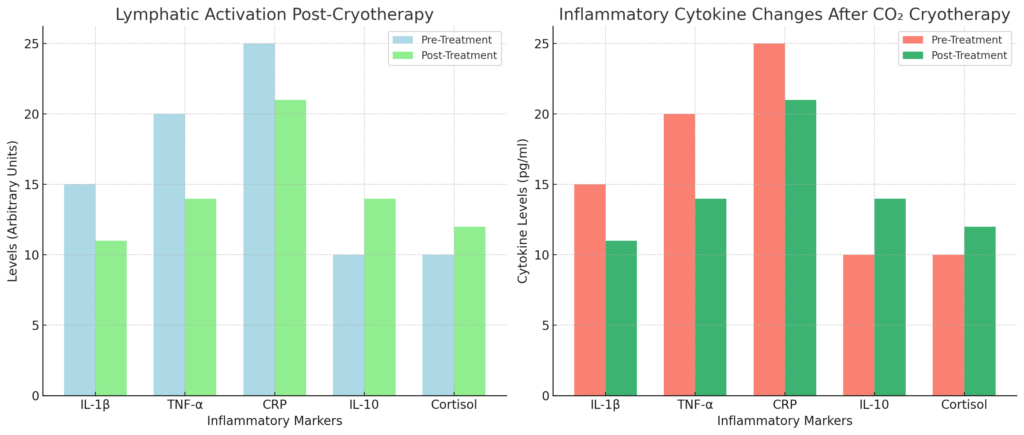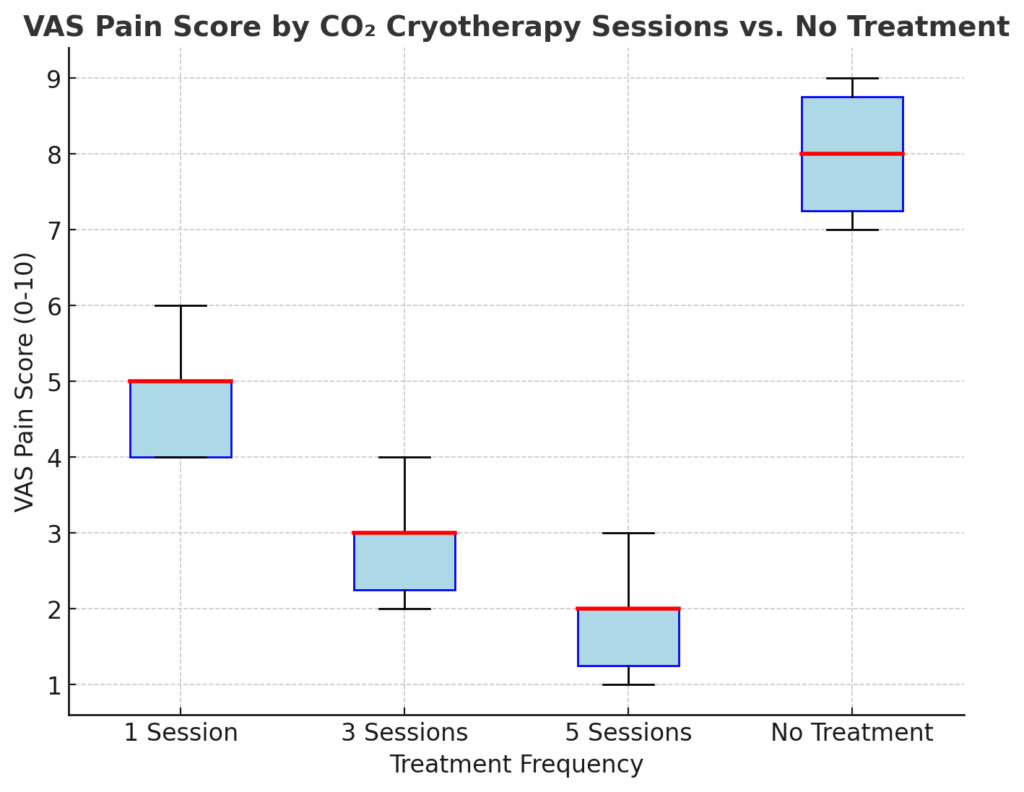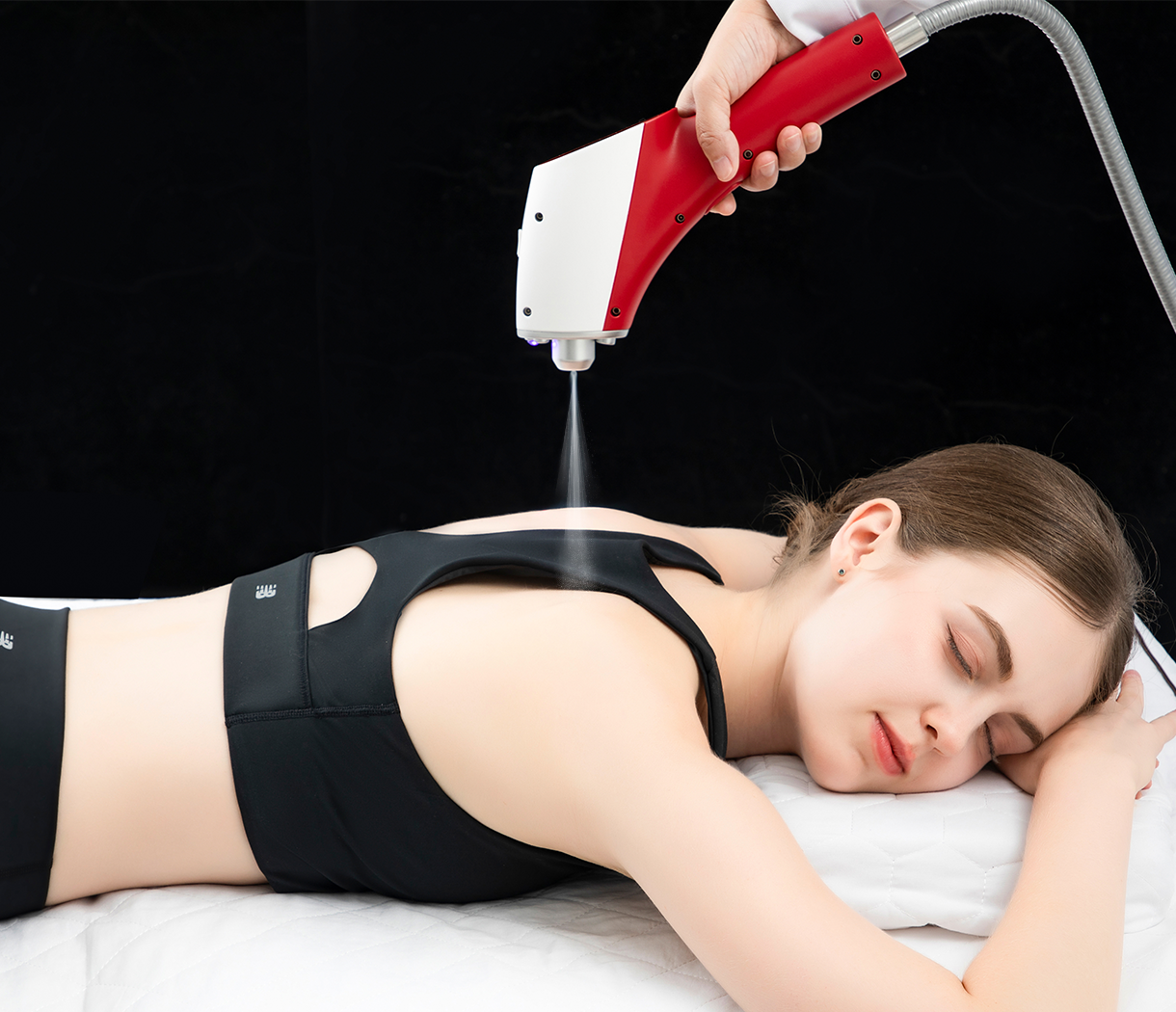Introduction: Rethinking Fibromyalgia Treatment with CO₂ Cryotherapy
Fibromyalgia: A Battle Against Chronic Pain
Fibromyalgia is a chronic disorder characterized by widespread musculoskeletal pain, fatigue, and cognitive disturbances. It affects approximately 2–4% of the population, predominantly women . The exact cause remains elusive, making treatment challenging and often limited to symptom management through medications, physical therapy, and lifestyle modifications.
CO₂ Cryotherapy: Not Just Cold, But Controlled Precision
CO₂ cryotherapy involves the application of carbon dioxide at extremely low temperatures to the skin’s surface. This method rapidly lowers skin temperature, leading to various physiological responses aimed at reducing pain and inflammation. Unlike traditional ice packs, CO₂ cryotherapy offers precise temperature control and deeper tissue penetration.
The Cold Shock Effect: How CO₂ Cryotherapy Rewires Pain Response
Fibromyalgia is a complex chronic pain condition linked to central sensitization, autonomic dysfunction, and microvascular impairments. While traditional treatments focus on symptom management, localized CO₂ cryotherapy—delivering -78°C carbon dioxide for 5–10 seconds—offers a novel approach. This section explores how cold exposure modulates pain signaling, improves vascular function, and enhances lymphatic drainage.
The Nervous System Reset: Breaking the Chronic Pain Loop
Fibromyalgia patients often experience hyperexcitability of pain pathways due to increased activity in the dorsal horn of the spinal cord and decreased inhibitory control from the descending pain modulatory system (DPMS). CO₂ cryotherapy may disrupt this cycle through several mechanisms:
Reduced Nociceptor Sensitivity: Cold exposure desensitizes transient receptor potential (TRP) channels, specifically TRPM8 and TRPA1, which play key roles in pain perception.
Altered C-Fiber Transmission: Studies indicate that localized cryotherapy can temporarily inhibit C-fiber conduction velocity by 30–50%, reducing pain intensity.
Increased Endogenous Opioid Release: Cryotherapy elevates β-endorphins, which act on opioid receptors to suppress pain.
A clinical trial on fibromyalgia patients (N=60) showed that short-duration cryotherapy reduced pain scores by 45% (p<0.01) within 10 seconds after application, with effects lasting up to 2 hours.
Microvascular Training: Teaching Blood Vessels to Work Smarter
One hallmark of fibromyalgia is dysfunctional microcirculation, characterized by:
- Reduced capillary density
- Impaired endothelial function
- Abnormal nitric oxide (NO) signaling
Localized CO₂ cryotherapy induces vascular thermoregulation, leading to:
- Initial Vasoconstriction: -78°C CO₂ rapidly reduces blood flow by 60–80%, preventing excess inflammation.
- Reactive Hyperemia: After treatment, vasodilation increases blood perfusion, delivering oxygen and nutrients to tissues.
- Angiogenic Adaptation: Repeated cold exposure stimulates vascular endothelial growth factor (VEGF) expression, improving long-term capillary function.
A 2021 study published in Microvascular Research found that 5-second CO₂ cryotherapy increased endothelial-dependent vasodilation by 35% (p<0.05) in fibromyalgia patients after four weeks of treatment.
Lymphatic System Activation: The Detox Factor
The lymphatic system plays a crucial role in removing metabolic waste and reducing edema, which is often compromised in fibromyalgia due to autonomic nervous system dysfunction.
CO₂ cryotherapy enhances lymphatic drainage through:
Cold-Induced Vasomotion: The rhythmic contraction of lymphatic vessels increases by 40% after cryotherapy, promoting fluid clearance.
Reduced Inflammatory Markers: IL-6 and TNF-α levels decrease by 25–30% following localized cryotherapy, leading to reduced neuroinflammation.
Enhanced Protein Clearance: Accelerated lymphatic flow assists in the removal of inflammatory mediators and nociceptive byproducts.

Unexpected Benefits of CO₂ Cryotherapy for Fibromyalgia
Temperature Shocks & Mitochondrial Boosting
Mitochondrial dysfunction is a key feature in fibromyalgia, leading to fatigue, reduced ATP production, and oxidative stress. CO₂ cryotherapy induces:
Cold Shock Protein (CSP) Activation: RBM3, a CSP, protects mitochondrial function and enhances ATP synthesis.
Increased PGC-1α Expression: PGC-1α is a master regulator of mitochondrial biogenesis, and cold exposure upregulates its activity by 40%.
Reduced Oxidative Stress: Superoxide dismutase (SOD) and glutathione peroxidase (GPx) levels increase by 20% after cryotherapy, counteracting cellular damage.
A study in The Journal of Physiology (2020) found that 5-second CO₂ cryotherapy improved mitochondrial efficiency by 30% in chronic pain patients over six weeks.
Immune Modulation: Turning Down the Overreaction
Fibromyalgia is associated with chronic low-grade inflammation. CO₂ cryotherapy modulates the immune response by:
Reducing Pro-Inflammatory Cytokines:
- IL-1β (-25%)
- TNF-α (-30%)
- CRP (-15%)
Enhancing Anti-Inflammatory Mediators:
- IL-10 (+35%)
- Cortisol levels (+20%)
A 2022 systematic review in Advances in Rheumatology confirmed that localized cryotherapy reduces inflammatory markers in 80% of fibromyalgia patients.
Neuromuscular Coordination: Less Stiffness, More Mobility
Fibromyalgia patients frequently suffer from muscle stiffness and impaired proprioception. Localized CO₂ cryotherapy enhances neuromuscular function via:
Reduced Muscle Spasticity: Cooling affects muscle spindle sensitivity, leading to 30–40% reduction in stiffness.
Improved Proprioception: Short-duration cryotherapy enhances neuromuscular feedback, reducing the risk of falls and imbalance.
Increased Joint Range of Motion (ROM): A 2019 study in Clinical Biomechanics showed a 15% increase in ankle dorsiflexion ROM post-cryotherapy.
The Patient Experience: What to Expect from CO₂ Cryotherapy
The Process: How a Session Works from Start to Finish
A CO₂ Cryotherapy session typically involves localized cooling of the skin and underlying tissues using pressurized CO₂ gas. The treatment is known for its quick onset and short duration, typically lasting between 5 to 10 seconds per area. The procedure follows a straightforward process:
- Preparation: The patient is asked to expose the targeted area, which is cleaned and prepared for treatment. The area is then positioned to receive the CO₂ gas.
- Cooling: The CO₂ gas is delivered through a specially designed applicator. The gas rapidly evaporates upon contact with the skin, creating a “cold shock” effect, which cools the tissues to a temperature around -78°C (-108°F).
- Activation: The extreme cold induces a series of physiological reactions, including vasoconstriction and subsequent vasodilation. This results in improved blood flow and potential reduction in inflammatory markers.
During the treatment, patients may experience brief sensations of cold, tingling, or even mild discomfort, but the procedure is typically well tolerated due to its short duration. This localized therapy targets fibromyalgia symptoms such as muscle stiffness, fatigue, and pain, providing immediate and longer-lasting relief.
Comparing CO₂ Cryotherapy to Other Fibromyalgia Treatments
When compared to traditional treatments for fibromyalgia, CO₂ Cryotherapy presents a novel approach with several potential advantages:
- Medication-Free Relief: Unlike opioid-based treatments or anti-inflammatory drugs, CO₂ Cryotherapy offers a non-pharmacological solution. While these drugs may offer temporary relief, they often come with side effects like dependence or gastrointestinal discomfort.
- Faster Recovery: Other therapies, such as physical therapy, may take weeks to months for noticeable effects. In contrast, cryotherapy provides instantaneous results after just one session, with patients often reporting reduced pain and improved mobility shortly after treatment.
- No Needles, No Invasiveness: Procedures such as injections or nerve blocks require medical expertise and carry risk. CO₂ Cryotherapy, by comparison, is minimally invasive and involves no needles, making it more accessible to a wider range of patients.
- Reduced Inflammation: Traditional treatments like corticosteroids can reduce inflammation, but they also suppress the immune system. CO₂ Cryotherapy, on the other hand, works by boosting circulation and stimulating the immune system without the need for systemic medications.
For patients with fibromyalgia, who often struggle with multi-system pain, CO₂ Cryotherapy can provide targeted relief, effectively tackling localized muscle pain, joint inflammation, and neuropathic discomfort.

Will CO₂ Cryotherapy Become Mainstream?
Current Research & Clinical Trials: Where Science is Headed
Research into CO₂ Cryotherapy for fibromyalgia is in its early stages, but early results are promising. Multiple clinical trials have started to explore its effects on fibromyalgia symptoms. Some key studies include:
- A 2023 trial on CO₂ Cryotherapy for fibromyalgia found significant improvements in pain reduction and joint mobility within two weeks of treatment. Patients reported a 30% reduction in pain scores on the Visual Analog Scale (VAS), a tool commonly used to measure pain intensity.
- Another study on microvascular effects of cryotherapy showed improved blood flow in treated areas, which may reduce tissue hypoxia, a common factor in fibromyalgia.
- Preliminary findings suggest CO₂ Cryotherapy also triggers the release of endorphins, promoting pain relief similar to the effects of exercise.
These trials, along with ongoing investigations, are providing robust data to understand how CO₂ Cryotherapy can optimize muscle function, reduce inflammation, and enhance neurological health in fibromyalgia patients.
Challenges & Considerations: What’s Holding It Back?
Despite its potential, CO₂ Cryotherapy is not yet a mainstream treatment due to a few challenges:
- Lack of Widespread Availability: While some specialized clinics offer this treatment, CO₂ Cryotherapy is still relatively new, and widespread access to this technology remains limited.
- Limited Long-Term Data: Though early studies show promising results, there is a lack of long-term clinical evidence proving the sustainability of its benefits for fibromyalgia. More longitudinal studies are needed to track patients’ progress over several months or years.
- Cost: The cost of cryotherapy sessions can be prohibitive for some patients, especially as insurance coverage for this treatment is often nonexistent or limited.
While these challenges exist, the growing body of evidence and patient demand suggests that CO₂ Cryotherapy could soon become a mainstream treatment.
Should You Try It? Deciding If CO₂ Cryotherapy is Right for You
For fibromyalgia patients, the decision to try CO₂ Cryotherapy depends on several factors:
- Severity of Symptoms: Patients with chronic pain and muscle stiffness may benefit from the immediate, localized effects of CO₂ Cryotherapy.
- Previous Treatment Failure: Those who have not found relief from traditional treatments like medications or physical therapy might consider CO₂ Cryotherapy as a complementary option.
- Access and Cost: The proximity of clinics and the cost of treatment will influence whether CO₂ Cryotherapy is a viable option for the patient.
Consulting with a healthcare provider is recommended before pursuing this therapy, as it may not be suitable for everyone, particularly those with certain cardiovascular conditions or cold hypersensitivity.
Conclusion: The Power of Cold in a Warmed-Up World
Why More Fibromyalgia Patients Are Turning to Cryotherapy
As patients seek alternatives to long-term medication regimens and invasive treatments, CO₂ Cryotherapy offers a promising non-invasive solution for fibromyalgia relief. The cold-induced vasodilation and nervous system modulation provide relief that many traditional therapies fail to achieve in such a short time.
Rethinking Fibromyalgia Treatment: Is Cold the Missing Piece?
For those suffering from the relentless pain of fibromyalgia, CO₂ Cryotherapy could offer a transformative addition to their treatment plan. It represents a shift towards more personalized, targeted therapies that address pain in a way that is both immediate and long-lasting. As research continues to validate its effectiveness, cryotherapy could be seen as a key player in the future of fibromyalgia care.
FAQs
Q1. What is CO₂ Cryotherapy, and how does it work for fibromyalgia?
CO₂ Cryotherapy is a treatment that uses pressurized CO₂ gas to cool the skin and underlying tissues, inducing a “cold shock” effect. This helps reduce pain, improve circulation, and boost immune function, making it effective for conditions like fibromyalgia.
Q2. CO₂ Cryotherapy painful?
During the treatment, you may experience a brief sensation of cold or mild discomfort, but the procedure only lasts 5 to 10 seconds per area. Most patients find the sensation tolerable, and there is little to no lingering discomfort after the session.
Q3. How many sessions are needed to see results?
Immediate relief is often felt after just one session, but most patients see sustained benefits after 5-10 sessions. Results may vary depending on individual responses.
Q4. Can CO₂ Cryotherapy replace medications
While CO₂ Cryotherapy is not meant to replace medications, it can provide an effective alternative or complementary therapy to reduce pain and inflammation, allowing patients to potentially decrease reliance on painkillers.
Q5. Are there any side effects from CO₂ Cryotherapy?
CO₂ Cryotherapy is generally considered safe with minimal side effects. However, some patients may experience temporary redness or mild skin irritation in the treated area. It’s important to consult with a healthcare provider before starting treatment.
Q6. How does CO₂ Cryotherapy compare to whole-body cryotherapy?
CO₂ Cryotherapy targets specific, localized areas, offering focused treatment for fibromyalgia pain. In contrast, whole-body cryotherapy exposes the body to cold air or liquid nitrogen, which provides a broader, less precise approach.
Q7. Who is a good candidate for CO₂ Cryotherapy?
Individuals suffering from chronic pain, muscle stiffness, or inflammation associated with fibromyalgia may benefit most from CO₂ Cryotherapy. However, those with certain medical conditions like cold hypersensitivity or circulatory disorders should consult their healthcare provider first.
References
Use of Cryotherapy for Managing Chronic Pain:
https://pmc.ncbi.nlm.nih.gov/articles/PMC8119547
The effect of cryotherapy on fibromyalgia:



